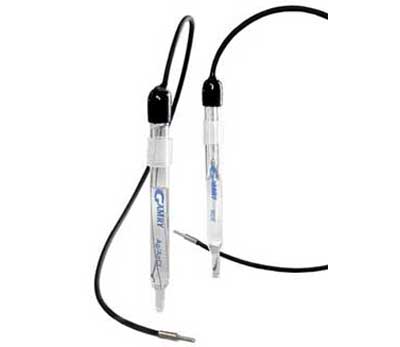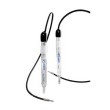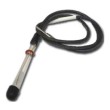Aqueous reference electrodes:
- Saturated Calomel (Hg2Cl2) - The saturated calomel electrode (SCE) is the most popular reference electrode. It has a reputation of being very stable and robust.
- Silver/Silver Chloride (Ag/AgCl) - The Ag/AgCl reference electrode is simpler in construction than the SCE and it contains no mercury. It is a very stable reference electrode.
- Mercury/Mercurous Sulfate Reference Electrode (Hg/Hg2SO4) - The Hg/HgSO4 reference electrode uses a filling solution of potassium sulfate. The Hg/HgSO4 reference electrode is recommended when chloride ion cannot be tolerated in the electrolyte.
- Mercury/Mercury Oxide (Hg/HgO) - Non-Aqueous reference electrode - a reference electrode based on the reaction between elemental Mercury and Mercury Oxide. Filled with potassium hydroxide (20% w/w). Electrode potential is 98 mV vs. Normal Hydrogen Electrode (NHE)
- Silver/Silver Nitrate non-aqueous reference electrode (Ag/Ag+) – The Ag/Ag+ reference electrode requires user assembly. It consists of a silver wire and one gram of silver nitrate powder. The AgNO3 powder should be dissolved in an appropriate electrolyte. Ideally, this electrolyte is the same as that used for the analyte (to eliminate junction potentials), an acetonitrile-based electrolyte can generally be used.
Pseudo-/Quasi-Reference Electrodes
Sometimes a classical reference electrode like an SCE isn't practical. For example, if you're doing three-electrode electrochemistry in the field, then a glass electrode is liable to break. For field work, many people use a metal probe made from the same material as the Working Electrode. Reference electrodes of this sort are termed pseudo- or quasi-reference electrodes (QRE).
With microelectrodes (ultra-microelectrodes) the current is very small so use of a 2-electrode setup with a combined counter/QRE may be acceptable. In this case silver metal (or platinum) is an ideal choice as a well-poised QRE. The best candidates for QRE’s are “well poised” materials. That means that the potential at the surface changes very little with any current that passes through them. All “true” reference electrodes are very well poised. While it is fairly common to use a corrosion-resistant alloy such as Hastelloy for your Reference Electrode, many of these materials are not well poised. Gamry does not recommend the use of Hastelloy psuedo-Reference Electrodes; mild steel is a much more well poised option.
Gamry has received numerous calls regarding reference electrodes for ionic liquids. Most ionic liquids cannot tolerate water and hence an SCE or Ag/AgCl reference electrode cannot be used. When working with ionic liquids, it is typically advisable to use a Ag wire when possible. In cases such as this, potentials are simply reported against the Ag/Ag+ couple, although it is best to dissolve a known compound such as ferrocene in the ionic liquid afterward and report potential against the ferrocene/ferrocenium couple.
High Temperature/Pressure Reference Electrodes: Autoclaves
The other application in which the Reference Electrode can be a major headache is high-temperature, high-pressure experiments in an autoclave. There are many reference electrode designs for autoclaves. One of the latest is "Simple and Robust External Reference Electrodes for High-Temperature Electrochemical Experiments" from Bosch, Bogaerts, and Zheng in CORROSION, Volume 59, page 163 (2003). That's the February 2003 edition.
Note: Since an autoclave is ALWAYS grounded, you must use a potentiostat that is electrically floating. All Gamry Potentiostats float—they are electrically isolated from ground—so they work very well in a grounded cell such as an autoclave. Because of this feature, Gamry Potentiostats are used in a wide number of laboratories for high-temperature experiments.
Cu/CuSO4 Reference Electrodes
Gamry does not supply a Cu/CuSO4 reference electrode but that doesn't mean we don't know about it. Plenty of our customers use a similar reference electrode for field work.
|
Reference Electrode
|
E vs. SCE
|
E vs. NHE
|
|
Cu/CuSO4 (sat'd)
|
0.074
|
0.0.316
|
Here are some valuable references regarding reference electrodes.
"Reference Electrodes. Theory and Practice." by Ives and Janz. This one is out of print but some sleuthing may turn up a copy somewhere.
"Electrode Potentials" by Compton and Sanders
"Reference Electrodes (Half-Cells)", J Lichtenstein, Materials Performance, Oct., 2001, p.68.






